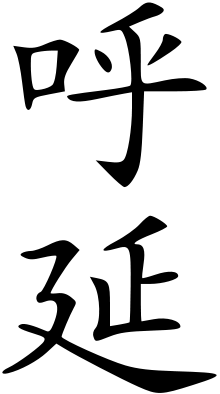Huyan
The Huyan (Chinese: 呼延; Wade–Giles: Hu-yen; Old Chinese: ZS *qʰaː-lan; B&S *qʰˤa-la[n]; LHC: *ha(C)-jan[1]) was a noble house that led the last remnants of the Northern Xiongnu to Dzungaria during the second century after the Battle of the Altai Mountains.
 Huyan in regular script | |
| Pronunciation | Hūyǎn (Pinyin) |
|---|---|
| Language(s) | Chinese |
| Origin | |
| Language(s) | Xiongnu language |
| Derivation | name of the earliest matrilineal ancestor of the Huyan clan |
The House of Huyan emerged during the political organization that came under Modun's reign which saw the Xiongnu reach its apogee.[2] It is an earlier maternal lineage name subsequently replaced by Xubu, much as the Ashina and Yujiulu (郁久閭).[3][4][5] The Mongolian Khiyad tribe's name is probably derived from Huyan.[6]
By the 3rd century BCE, the upper stratum of the Xiongnu was made up of five aristocratic houses, Luandi (house of the Chanyu and the Tuqi King of the east and west), Huyan, Xubu, Qiulin and Lan. Both the Huyan and Xubu settled in the east, Qiulin and Lan in the west and Luandi at the center of Mongolia.[3][4][7]
Around the first century BCE, a supreme administrative council dominated the upper Xiongnu hierarchy and this was composed of six top-ranking nobles, which included the "Rizhu kings" of the Left and Right.[8] These titles were later transferred to the Huyan clan, which became influential due its close relationship with the royal family by way of marriage.[8]
Historical record also cited a Huyan tribe called Barkol, which attacked and demolished the Yiwu garrison of the Han dynasty in 151.[9]
Prominent people with family name Huyan
- Empress Huyan, wife of Han Zhao's founding emperor, Liu Yuan
- Empress Huyan, wife of Liu Yuan's son, Liu Cong, the fourth emperor of Han Zhao
- Empress Huyan, wife of Murong Chao, emperor of the Southern Yan
- Huyan Zan (呼延贊), general of the Song dynasty (d. 1000)
- Huyan Zhuo (呼延灼), fictitious descendant of Huyan Zan in Water Margin, one of the Four Great Classical Novels
Notes
- Schuessler, Axel. (2007). ABC Etymological Dictionary of Old Chinese. University of Hawaii Press.. p. 280, 553
- Ebrey, Patricia Buckley (1981). Chinese Civilization: A Sourcebook, 2nd Ed. New York: The Free Press. pp. 55. ISBN 002908752X.
- Lin (1986), p. 33–45, 114-119
- Wang (2004), p. 132–147,
- Bichurin N.Ya., "Collection of information on peoples in Central Asia in ancient times", vol. 1, Sankt Petersburg, 1851, p. 15 ( note 1: Huyan and Xubu always were in marital relationship with the Chanyu. Xubu had a post of the State Judge. The custom of taking for the Khan maidens only from the same houses also survived in the Chingis-khan's house.)
- History of Mongolia, Ulaanbaatar, 2003
- Gumilev L.N., "Hunnu in China", Moscow, 'Science', 1974
- Kim, Hyun Jin (2016). The Huns. Oxon: Routledge. p. 14. ISBN 9781138841710.
- Schellinger, Paul; Salkin, Robert (2010). Asia and Oceania: International Dictionary of Historic Places. Volume 5. Oxon: Routledge. p. 321. ISBN 1884964044.
References
- Lin, Gan (1986). A Comprehensive History of Xiongnu. Beijing: People's Press. CN / K289.
- Wang, Zhonghan (2004). Outlines of Ethnic Groups in China. Taiyuan: Shanxi Education Press. ISBN 7-5440-2660-4.
- Gumilev L.N., "Hunnu in China", Moscow, 'Science', 1974, ISBN 5-85990-092-9